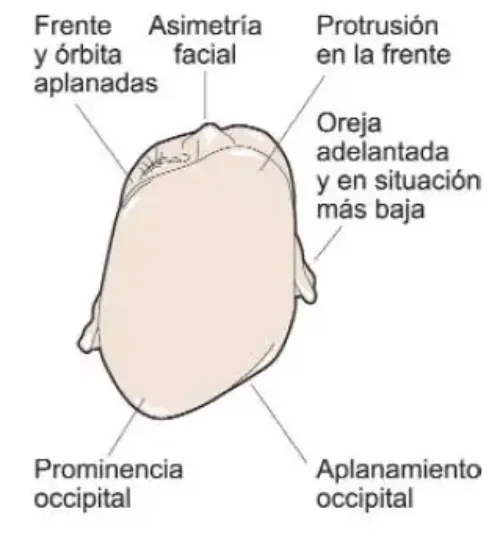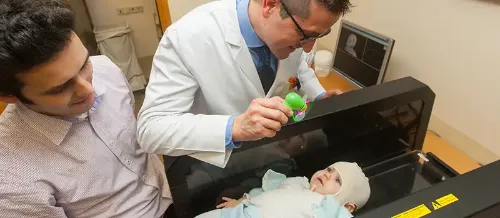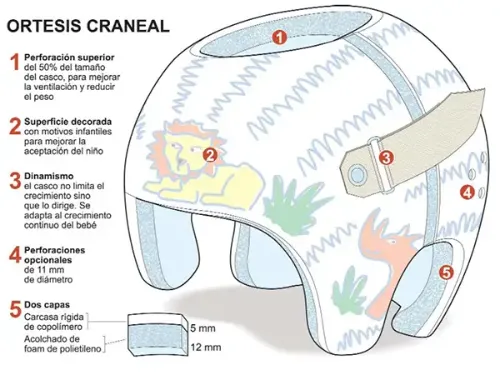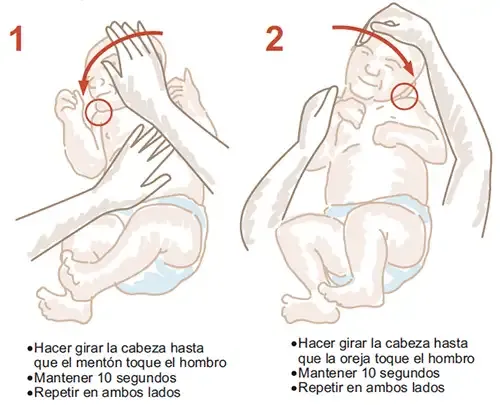Plagiocephaly
"The cranial orthosis does not limit growth but directs it to the parts where the skull has been deformed. Normally, in less than 3 months the problem is solved".
DR. ROCÍO SÁNCHEZ-CARPINTERO
DIRECTOR. NEUROPEDIATRICS UNIT

What is plagiocephaly?
Postural plagiocephaly is the most common craniofacial anomaly and consists of a flattening of the child's occiput with facial asymmetry.
It does not affect the intellectual development of the child but it is recommended to correct it because of the aesthetic problems that it entails.
For the diagnosis of this malformation and the subsequent follow-up of the treatment, the Orthopedic Workshop of the Department of Orthopedic Surgery and Traumatology of the Clinic has a specific scanner (Starscanner) that allows to take the measurements with accuracy in less than 5 minutes and in a totally innocuous way for the child.
This scanner replaces the need to take the measurements with a plaster cast, collects the data in 3D and these are quickly transmitted to the American company in charge of manufacturing the cranial orthosis.

What are the symptoms of plagiocephaly?
Positional head deformities are usually corrected spontaneously with the child's development in the first 6-8 weeks of life.
If they do not resolve or improve with the positional changes of the infant's head and with neck stretching exercises, from 4 months onwards, treatment can be considered by means of dynamic orthotic cranioplasty (cranial orthosis).
Most common symptoms:
- Cranial deformity.
- Facial deformity.
- Cervical muscle contracture.
Does your child have this problem?
You may need to be fitted with a head brace
What are the causes?
Positional plagiocephaly is due to external pressures on the skull either intrauterine (during fetal life), at the time of delivery, due to long stays in the incubator, or by the posture of the child while sleeping.
It can also be caused by congenital muscular torticollis, which leads the child to lean always on the same area of the head.

How is plagiocephaly diagnosed?

For the diagnosis of this malformation and the subsequent follow-up of the treatment, the Orthopedic Workshop of the Department of Orthopedic Surgery and Traumatology of the Clinic has a specific scanner (Starscanner) that allows to take the measurements with accuracy in less than 5 minutes and in a totally innocuous way for the child.
This scanner replaces the need to take the measurements with a plaster cast, collects the data in 3D and these are quickly transmitted to the American company in charge of manufacturing the cranial orthosis.
How is plagiocephaly treated?

Helmet - Cranial orthosis
The cranial orthosis is a special skull shaping helmet, made to measure, to correct these deformities in newborns.
Is the pediatrician and the parents themselves who detect this alteration in the periodic check-ups that are carried out on the babies. When the pediatrician considers that a more specific treatment is necessary, a technician from the Orthopedic Workshop of the Orthopedic Surgery and Traumatology Department of the Clinic will take the measurements with the new scanner. These measurements are sent to the company that makes the custom-made orthosis. Once received in the Clinic, the technician finalizes the process of adaptation and adjustment to the baby.
The cranial orthosis does not limit the growth of the skull but directs it towards the parts where the skull has suffered this deformation, looking for the symmetry of the head.
The Department of Pediatrics carries out a periodic follow-up, as in the Orthopedic Workshop, to evaluate the evolution and correct the possible deviations that accompany the child's own growth.

Tips and exercises for improving plagiocephaly
During the first weeks of the newborn's life and up to 4-8 weeks it is advisable to monitor the infant especially.
When the child is lying on his back, he should not always be placed with his head on the same side, alternating the position of his head to the left and right. It may be helpful to change the position of the crib towards the light or another object that requires the child's attention.
Exercises for plagiocephalyIf the baby has limited neck mobility (muscle contracture), often associated with plagiocephaly, we must teach parents neck mobilization exercises as part of the child's care.
Chin-shoulder exercise: place one hand on the chest or shoulder and with the other, gently rotate the head, maintaining that position for 10 seconds.
Ear-shoulder exercise: with the child in a supine position, place one hand on the shoulder opposite the side we intend to bend. With the other hand, placed on the top of the head, it is inclined with the intention that the ear touches the shoulder. The position is maintained for 10 seconds.
Both exercises will be repeated 3 to 5 times a day, 3 to 5 times each, until complete rehabilitation of the mobility of the neck is achieved.
From the first month, when you are awake and monitored, you can place the baby for a while on your abdomen, face down. This relieves the pressure on the skull and helps strengthen the cervical and spinal muscles, preparing the baby for crawling.
From the third month, it can be placed in front of a mirror and with sound or light toys, will help maintain that position and stimulate the senses.
In the strollers and other devices, it will be necessary to avoid that the head always remains lateralized towards the same side by prolonged periods.
Where do we treat it?
IN NAVARRA AND MADRID
The Department of Pediatrics
of the Clínica Universidad de Navarra
All our specialists work exclusively and, in addition, since we have all the technology in the same center, we offer the performance of tests and diagnosis in less than 72 hours.
We have a team of highly qualified professionals to attend the different specialized units: Oncopediatrics, Neuropediatrics, Endocrinopediatrics, Neonatology, etc.
Organized in specialized units
- Neonatology Area.
- Pediatric Endocrinology.
- Pediatric Cardiology.
- Pediatric Neuropediatrics.
- Digestive and pediatric nutrition.
- General and preventive pediatrics.
- Pediatric Pneumology.

Why at the Clinica?
- Comprehensive care of the child.
- Professionals who are experts in the different areas for a better diagnosis and treatment.
- Equipped with the latest technology for newborn care.


























